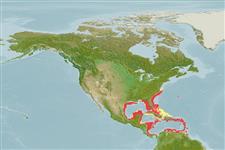Environment: milieu / climate zone / depth range / distribution range
Ecología
marino demersal; rango de profundidad ? - 146 m (Ref. 58018). Subtropical; 38°N - 9°N
Western Atlantic: Virginia, USA and Bahamas to Venezuela.
Tamaño / Peso / Age
Maturity: Lm ? range ? - ? cm
Max length : 33.4 cm TL macho / no sexado; (Ref. 55642)
Espinas dorsales (total) : 12; Radios blandos dorsales (total) : 9; Espinas anales: 3; Radios blandos anales: 5. Snout short and almost equal to orbit diameter; third dorsal spine not elongated (Ref. 13608).
Have a thick glandular tissue on posterior margin of fin spines which is believed to be venomous (Ref. 57406).
Life cycle and mating behavior
Madurez | Reproducción | Puesta | Huevos | Fecundidad | Larva
Robins, C.R. and G.C. Ray, 1986. A field guide to Atlantic coast fishes of North America. Houghton Mifflin Company, Boston, U.S.A. 354 p. (Ref. 7251)
IUCN Red List Status (Ref. 130435: Version 2024-1)
Human uses
Herramientas
Special reports
Download XML
Fuentes de Internet
Estimates based on models
Preferred temperature (Ref.
123201): 22.3 - 28, mean 25.9 °C (based on 330 cells).
Phylogenetic diversity index (Ref.
82804): PD
50 = 0.5000 [Uniqueness, from 0.5 = low to 2.0 = high].
Bayesian length-weight: a=0.01096 (0.00644 - 0.01868), b=3.07 (2.92 - 3.22), in cm total length, based on LWR estimates for this species & (Sub)family-body (Ref.
93245).
Nivel trófico (Ref.
69278): 3.5 ±0.5 se; based on size and trophs of closest relatives
Resiliencia (Ref.
120179): Medio, población duplicada en un tiempo mínimo de 1.4-4.4 años (Preliminary K or Fecundity.).
Fishing Vulnerability (Ref.
59153): Low vulnerability (23 of 100).
